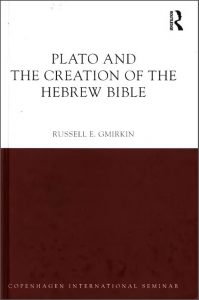
Russell Gmirkin in his new book, Plato and the Creation of the Hebrew Bible draws attention to striking similarities between the Pentateuch (the first five books of the “Old Testament”) on the one hand and Plato’s last work, Laws, and features of the Athenian constitution on the other. . . . . The key to this close linkage is the Great Library of Alexandria.
The main stimulus for Gmirkin’s new study is a desire to examine more closely some of the parallels presented by Philippe Wajdenbaum in Argonauts of the Desert: Structural Analysis of the Hebrew Bible. (Again, see earlier Vridar posts on Argonauts.) According to the Acknowledgements in Plato and the Creation of the Hebrew Bible it was Thomas L. Thompson who suggested this study to Russell Gmirkin, and Gmirkin explains that his focus was on Wajdenbaum’s discussion of the parallels between Plato’s Laws and the Pentateuchal laws as the most persuasive section of his book.
–o–
Compares Greek and Judean constitutions and governing institutions as documented in their respective literature. Examines the specific interests within this distinctive Greek form of literature with the topics of interest in the Pentateuchal law codes as well as the sorts of narratives in which they were embedded. Table format for easy comparison.
–o–
Compares the attributes of David with those set out for an ideal Athenian. In table format sets out striking similarities between tribal and military organization of as per the Greek and Hebrew literature, as well as specific details of soldiering and battles.
–o–
A discussion on how circular reasoning and naive assumptions can close our minds to the possibility that the Hebrew Bible could possibly be a later Hellenistic work. References are made to Dale C. Allison, Philip R. Davies, Niels Peter Lemche.
–o–
Demonstates that the biblical tribal structure of Israel is unknown elsewhere in the ancient Near East but does reflect the Greek tribal system.
–o–
A table setting out comparisons between Greek and Biblical councils and assemblies, their memberships and responsibilities.
–o–
A table comparing Greek and Biblical judicial systems from local through to “national” levels.
–o–
The Law of Moses placed limitations on the king that are “without parallel in the ancient Near East.” The limitations are found in Greek literature and customs.
–o–
Evidence that the Bible’s account of priests and prophets contains hints of borrowing from the Greek world. (Not that those Hellenistic features mean we have to jettison entirely sources and influences closer to the Levant.)
–o–
This post addresses an objection from a Vridar reader to Gmirkin’s argument for Greek institutions being the model of the Bible’s assemblies and offices. I bring in support for the Gmirkin’s case from other publications by Thorkild Jacobsen, Abraham Malamat, Yves Schlemiel and M.L. West, with particular reference to the Epic of Gilgamesh.
–o–
If the Pentateuch was authored at the Great Library of Alexandria, then we would have a ready explanation for the international setting of Deuteronomy 4:6-8. All the law codes and discussions of constitutions and principles of the framing of ideal laws were housed there. It is not unreasonable to argue that the Mosaic laws were composed in dialogue with this literature. Greek influence was conceivably mediated most easily through Egypt’s centres of learning and Great Library.
–o–
Compares biblical homicide laws with those in Near East codes and principles set out by Plato. Specifics covered:
-
- state of mind,
- exile,
- pollution of the land,
- duty of relatives,
- temple sanctuary,
- stoning,
- the goring ox.
–o–
Gmirkin gives the most attention in his comparative discussion of historical narrative backgrounds to the institution of law codes and political institutions to Hecataeus but I am interested in exploring how well other material also relates to his central thesis, so bring in Plutarch’s narrative of Theseus for comparison.
–o–
Demonstrations of narrative background to lawgivers found in the literature of Thucydides, Herodotus, Isocrates and Aristotle and their similarities with the biblical narratives.
–o–
I compare a section in Plato’s Timaeus and its relevance to Gmirkin’s thesis.
–o–
Identifies the common elements of Greek (and Roman) foundation stories (Cyrene, Heraclidae) and notes their occurence in the biblical foundation myths as well as in a Judean foundation myth independent of the biblical account (Hecataeus of Abdera).
–o–
With reference to Moshe Weinfeld’s The Promise of the Land: The Inheritance of the Land of Canaan by the Israelites we extend Gmirkin’s comparison to Roman foundation stories. Weinfeld explains the relevance of the comparison by noting that the Roman myth originated centuries prior to its more famous versions in the Augustan age.
–o–
Quotations from Moshe Weinfeld’s book (see #17 above) that explain his justification for his comparisons.
–o–
Looks at one more type of narrative that is found in common between Greek literature and Primary History (Genesis to 2 Kings). The point is that the same type of story is said to be alien to Near Eastern literature so apparently the only known model for the biblical narratives is found in the Greek writings of Thucydides, Plato and Aristotle.
–o–
Outlines the main arguments of the first five chapters.
–o–
Comparing the ten commandments with sayings of Greek sages and the commandments of Delphi.
–o–
As per the title: a table making it easy to see the similarities and differences among Biblical, Greek and Mesopotamian laws concerning
-
- homicide
- and the goring ox.
–o–
Another table setting out clearly the similarities and differences among Biblical, Greek and Mesopotamian laws, this time focusing on
-
- assault,
- two men fighting who injure a pregnant woman nearby,
- and theft.
–o–
Tables marking similarities and differences among Biblical, Greek and Mesopotamian laws concerning
-
- marriage and inheritance
- permitted sexual relations
- prohibited sexual relations
–o–
Tables comparing the laws from the three provenances concerning
-
- slavery
- debt and freeborn slaves
- chattel slaves
- social welfare legislation
–o–
Table comparisons (Bible, Greece, Mesopotamia) of laws on
-
- trespassing
- passers-by eating from the fields
- boundary stones
–o–
This post delves into a secondary source used by Gmirkin in his discussion of military law as set out in Deuteronomy. The extracts are from Anselm C. Hagedorn’s Between Moses and Plato: Individual and Society in Deuteronomy and Ancient Greek Law.
–o–
Even the biblical laws relating to impiety, sorcery, blasphemy, that many of us associate with religious barbarism find their counterparts in “more enlightened” and “philosophical” Greek literature.
–o–
Continuing directly on from the previous post this post covers the two most well-known Athenian trials that mirror the Pentateuchal laws against private and innovative religious practices and deities:
-
- against Alcibiades
- against Socrates
–o–
Looks at a review by Stéphanie Anthonioz of Russell Gmirkin’s Plato and the Creation of the Hebrew Bible that was posted on The Bible and Interpretation. Anthonioz opens up an interesting discussion over different possible explanations for the clear and striking similarities between Plato and the Pentateuch that Russell Gmirkin has detailed.
–o–
As per the title: Gmirkin’s response to Anthonioz’s review.
–o–
Again addressing Moshe Weinfeld’s The Promise of the Land: The Inheritance of the Land of Canaan by the Israelites. The post covers a typological comparison of the roles of the ancestors of Rome and Israel. I have tried to capture the main outline.
-
- A Man Leaving a Great Civilization and Charged with a Universal Mission
- Gap Between Migration of the Ancestor and the Actual Foundation
- Promise at Stake
- The Pious Ancestor
- The Ancestral Gods
- Burial Place of the Founder
- Canaan versus Aram, Rome versus Carthage
–o–
A list of all the posts I have completed so far on Russell Gmirkin’s book, Plato and the Creation of the Hebrew Bible. including a link to an extended abstract or chapter by chapter outline by Gmirkin himself on his academia.edu page.
–o–
After having demonstrated the many details, themes and values that the books of the Hebrew Bible share with Greek literature, practices and ideas, Russell Gmirkin concludes with a chapter examining how closely the biblical canon appears to match Plato’s recommendations for a national curriculum. There are certainly Canaanite and Mesopotamian fingerprints in the “Old Testament” but these Scriptures are unlike anything else produced in the ancient Near East. The Hellenistic heritage explains that difference.
–o–
I have made a correction to a serious error in my recent post How Plato Inspired Moses: Creation of the Hebrew Bible. In that post I took credit for identifying many parallels between the Hebrew Bible and Plato’s Laws prior to reading Russell Gmirkin’s book. I should have acknowledged — and I have now made the correction — that my interest in Plato’s Laws was sparked by Philippe Wajdenbaum’s Argonauts of the Desert: Structural Analsysis of the Hebrew Bible.
–o–
–o–
The following posts bring Russell Gmirkin’s thesis into engagement with a more mainstream view set out in other posts covering Seth Sanders’ From Adapa to Enoch:
I have been posting on points of interest in Seth Sanders’ From Adapa to Enoch: Scribal Culture and Religious Vision in Judea and Babylon and have reached a point where I cannot help but bring in certain contrary perspectives from Russell Gmirkin’s Plato and the Creation of the Hebrew Bible.
–o–
Further comparisons between a conventional view of Mesopotamian-Biblical influence and the alternative view that the Greek world is a better explanation for the Biblical content.
Like this:
Like Loading...


